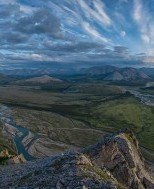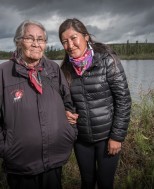Application for leave to appeal to be filed with Supreme Court of Canada
After careful consideration of the Yukon Court of Appeal’s decision in the Peel Watershed case, the First Nation of Nacho Nyak Dun, the Tr'ondëk Hwëch'in, the Vuntut Gwitchin First Nation, CPAWS Yukon and Yukon Conservation Society have decided to apply for leave to appeal the decision to the Supreme Court of Canada.
The application for leave to appeal will address the Yukon Court of Appeal’s ruling that the process for land use planning for the Peel Watershed should be sent back to the stage of consultation on the Recommended Peel Watershed Regional Land Use Plan, released in December 2009. The application will also seek leave to appeal the Yukon Court of Appeal’s interpretation of the procedure followed for land use planning in the Yukon under Chapter 11 of the Final Agreements between Canada, Yukon and Yukon First Nations.
The ruling of the Yukon Court of Appeal effectively returns the land use planning process to a stage completed approximately four years ago and allows the Yukon government to re-do its consultation with the First Nations and the public and then to choose whether to approve, reject or propose modifications to the Recommended Peel Watershed Regional Land Use Plan. In the application for leave to appeal the applicants will argue that this ruling was a mistake in law and that it does not uphold the integrity of the Final Agreements. The Yukon Court of Appeal also ruled that proposing modifications to a regional land use planning commission’s recommended plan does not preclude the Yukon government from rejecting the plan after final consultation. In the application for leave, the applicants will argue that this was a mistake in the interpretation of the Final Agreements and that it introduces substantial uncertainty in future land use planning processes in Yukon.
“This judgment, of the highest court in Yukon, will now govern land use planning not only in the Peel, but in every region of Yukon, as planning proceeds, for years to come,” stated lead lawyer for the respondents, Thomas R. Berger, Q.C., “It must be appealed.”
Chief Roberta Joseph of the Tr'ondëk Hwëch'in added to this, stating, “There are important questions that merit consideration by the Supreme Court of Canada. We will continue doing all we can to protect the integrity of our agreements and the Peel.”
Interim Executive Director of CPAWS Yukon, Jill Pangman, spoke to the importance of the Peel Watershed to the public, stating, “In a world that's becoming increasingly industrialized and fragmented, the most valuable resource Yukon can offer is its wildness. Yukoners spoke loud and clear over the years of consultations. The majority want to see the Peel Watershed protected. They recognize that the region's wilderness values, ecological integrity and remarkable landscape are far too precious to squander for short term monetary gain.”
"The Peel Watershed has been home to the Gwitch’in for millennia. Generations of both Vuntut and Tetlit Gwitch’in have been sustained by the life that has flourished here. Of particular importance to the Gwitch’in Nation are the Porcupine caribou that migrate through the watershed each year. Because of all of this we stand strong on seeking protection for the Peel,” added Chief Roger Kyikavichik of the Vuntut Gwitchin First Nation.
Looking beyond the Peel, to land use planning processes throughout the Territory, Yukon Conservation Society Executive Director Christina Macdonald said, “This court case is critical not only for protecting the Peel Watershed but for all future land use planning in the territory. This process allows all of us to have a say in how our natural environment is protected, developed and managed. For this reason we are committed to seeing a just process upheld.”
Chief Simon Mervyn of the First Nation of Nacho Nyak Dun concluded with the words, “Our old people lived and survived off the land. They depended upon the animals and plants, the clean air and water. They understood that as humans we cannot own the land, but that it is our job to protect it. We have seen the impact industry is having on the lands and waters of the Territory and we are determined that this will not happen in the Peel Watershed. "
Once the application is filed with the Supreme Court of Canada, the Yukon government will have 30 days to respond to the application for leave to appeal. This will be followed by a further 10 days for the applicants to file any reply to the Yukon government’s arguments. Three judges of the Supreme Court of Canada will then decide whether leave to appeal is granted. A decision from the Supreme Court of Canada on whether to allow the application for leave to appeal may take a number of months.
We expect to file the application in the next few days.
Back to all news »






